Companion planting with asparagus is like inviting friends over to help your garden thrive. Imagine your asparagus plants surrounded by a team of plants that help each other grow better, fight off pests, and produce more delicious spears. It’s a gardening technique that uses the natural friendships between plants to create a happier and healthier garden. Asparagus, a favorite spring vegetable, loves hanging out with certain plants. These buddies can protect asparagus from pesky insects, enrich the soil, and even make each other taste better!
So, let’s dive into the world of companion planting with asparagus. It’s an adventure that makes gardening more fun, your plants healthier, and your harvests bigger. Plus, it’s a great way to get the most out of your garden space and enjoy gardening to the fullest
Understanding Companion Planting with Asparagus
Companion planting asparagus dives deeper into the art of gardening by harnessing natural relationships between plants. This method, rooted in both tradition and science, optimizes the health and yield of asparagus by closely aligning it with beneficial plants. Essentially, it creates a thriving community where each plant brings something valuable to the table, enhancing the overall ecosystem.
Through this practice, we leverage the strengths of each plant to counteract common gardening challenges. For instance, certain companions can improve the soil’s structure and fertility, directly benefiting the asparagus with nutrients essential for its growth. Others might offer shade or structural support, creating a microclimate that suits asparagus perfectly.
Moreover, companion planting aims to achieve a harmonious balance, reducing the need for chemical interventions. It encourages biodiversity, inviting beneficial insects that contribute to the pollination process and natural pest control. This approach not only promotes a healthier garden but also contributes to the sustainability of the environment.
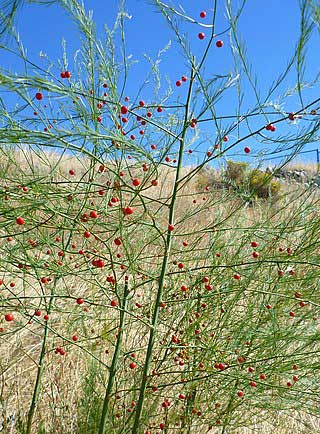
Ideal Conditions for Growing Asparagus
Sunlight and Soil: The Foundation of Asparagus Growth
Growing asparagus begins with ensuring they receive ample sunlight and are planted in well-drained soil. These green spears flourish under the full gaze of the sun for 6 to 8 hours daily, which is crucial for their health and the bounty of your harvest. The right soil conditions are equally vital; asparagus thrives in soil that is rich in organic matter and well-drained to prevent root rot. Ensuring your soil has a pH between 6.0 and 7.0 will set the stage for optimal asparagus growth.
Planting Strategy: Space and Protection
The spacing of asparagus crowns is essential to avoid overcrowding, with recommendations to plant crowns about 12 to 18 inches apart. Row spacing is also important, allowing for easy access during maintenance and harvest. Additionally, considering wind protection can safeguard the tall, slender asparagus plants from damage. Utilizing natural windbreaks or strategic planting can offer the shelter needed to thrive.
Choosing a Permanent Home for Asparagus
Selecting a permanent location for asparagus is crucial, as these plants are long-term residents of your garden, producing year after year. Once planted, asparagus prefers not to be moved, requiring a space where they can grow undisturbed for many seasons. This commitment to a specific spot in your garden underscores the importance of the initial site selection for successful asparagus cultivation.
The Best Companion Plants for Asparagus
Pairing asparagus with the right companion plants is like finding the perfect teammates for a garden game. Let’s talk about some of the best companions that bring out the best in asparagus.
Vegetables and Fruits
Tomatoes
Tomatoes and asparagus are like best buddies in the garden. Tomatoes help keep those pesky asparagus beetles at bay, thanks to a natural repellent they produce. At the same time, asparagus can fend off root-knot nematodes, which sometimes bother tomatoes. Together, they create a mutual protection pact that keeps both plants happy and healthy.

Eggplant
Sharing the same family tree with tomatoes, also enjoys the company of asparagus. Eggplants benefit from the pest-deterrent qualities of asparagus, making them less likely to encounter common enemies. Plus, planting eggplants near asparagus can add a beautiful diversity to your garden’s layout and helps in keeping the soil healthy for both plants.

Strawberries
Not only make the garden look pretty with their bright red fruits and lovely flowers, but they also play a practical role when grown near asparagus. Strawberries act as living mulch, spreading across the ground and helping keep weeds at bay. This relationship saves you time and effort in weeding, and the strawberries get to enjoy the asparagus’s company without competing for resources.
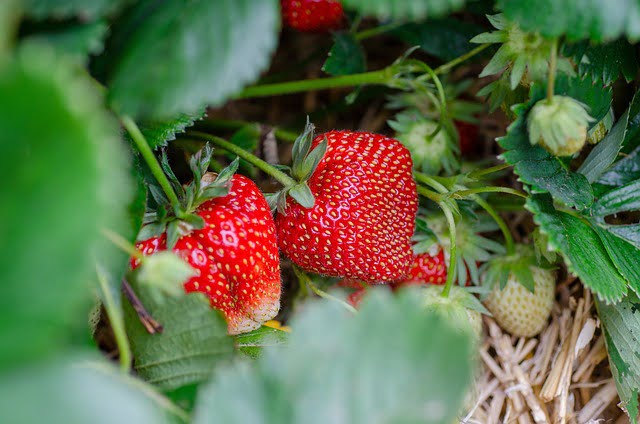
Peas
are another fantastic companion for asparagus, bringing a lot of benefits to the soil. Peas are known for their ability to fix nitrogen from the air into the soil, enriching it for themselves and their neighbors, including asparagus. This process naturally fertilizes the soil, reducing the need for chemical fertilizers and promoting a more organic garden environment.
Read About: Companion Plants For Peas

Lettuce
Planting lettuce near asparagus can significantly enhance your garden’s productivity and visual appeal. Lettuce, with its shallow root system, is an ideal low-growing companion that won’t compete for deep soil nutrients. This quality makes lettuce a perfect fit for the underutilized space around asparagus, allowing for a fuller use of garden real estate. Additionally, lettuce thrives in the partial shade provided by the tall ferns of mature asparagus, protecting it from the harsh midday sun. This symbiotic relationship not only conserves space but also extends the lettuce growing season, providing fresh greens for your table longer than if grown alone.

Spinach
Spinach, brings its own set of benefits when grown alongside asparagus. Like lettuce, spinach appreciates the cooler, shaded environment created by asparagus ferns. This leafy green also contributes to a healthier garden ecosystem by covering bare soil quickly, which can help suppress weeds and maintain soil moisture—benefits that asparagus, with its preference for well-drained soil, appreciates. Spinach’s relatively quick growth cycle means it can be harvested before it ever competes with asparagus, ensuring both can coexist without hindering the other’s development.

Herbs
Herbs not only add flavor to our meals but also play a significant role in the garden, especially when it comes to companion planting with asparagus. Let’s explore how some of our favorite herbs can benefit asparagus plants.
Basil
It is a fantastic herb that does more than just enhance our favorite dishes. In the garden, basil acts as a strong ally for asparagus by repelling unwanted pests and attracting pollinators. Its strong scent wards off harmful insects, while bees and butterflies are drawn to its flowers, helping to pollinate your garden. This makes basil plants excellent neighbor for asparagus, ensuring a healthier and more fruitful garden.

Dill
Dill is another herb that’s great to have around asparagus. Dill attracts beneficial insects like ladybugs and wasps, which feed on common garden pests. At the same time, dill can repel certain pests that might otherwise harm your asparagus. Planting dill nearby means you’re setting up a natural defense system for your garden, reducing the need for chemical pest controls.

Parsley
Parsley might be known for garnishing dishes, but in the garden, it’s a powerhouse at attracting beneficial insects. Like dill, parsley invites the good bugs that help keep pest populations in check. This makes parsley a valuable companion for asparagus, contributing to a balanced and healthy garden ecosystem.
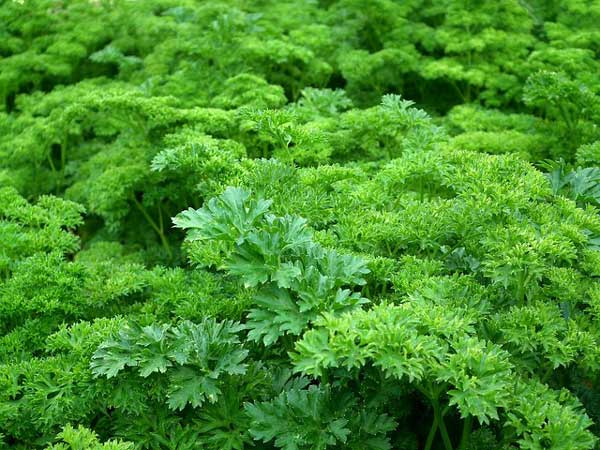
Cilantro
Cilantro, with its fresh aroma and taste, is more than just a culinary delight. In the garden, cilantro repels aphids and other pests, protecting asparagus and other plants from damage. It’s like having a natural pest control agent right at your fingertips. Plus, cilantro blooms attract pollinators, adding to the garden’s biodiversity.
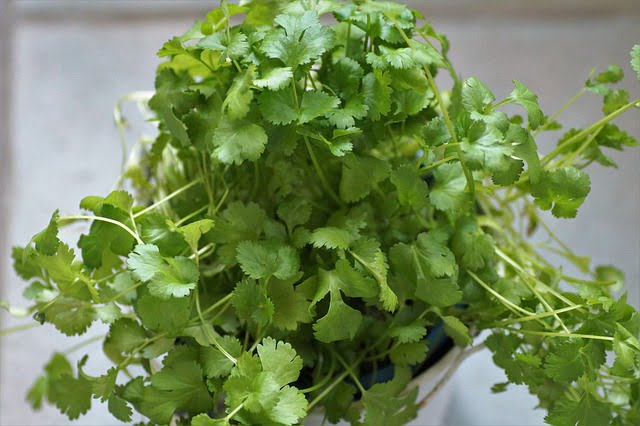
Lavender
Planting lavender alongside asparagus benefits both plants. Lavender repels pests, attracts pollinators, improves soil, and enhances the garden’s appearance.
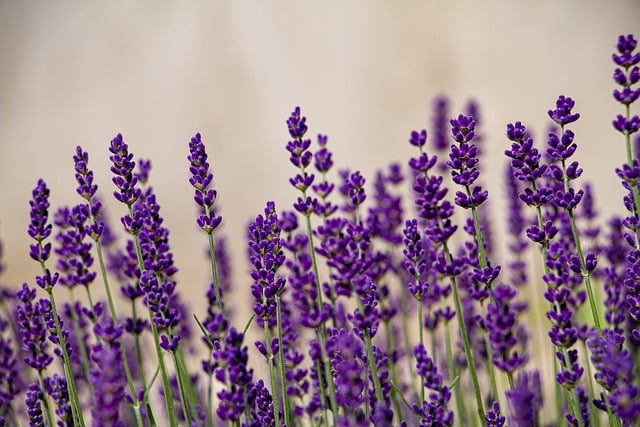
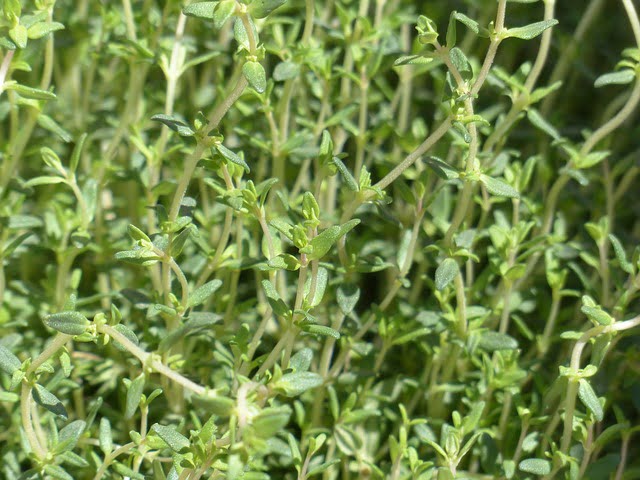
Incorporating these herbs into your asparagus bed not only fosters a vibrant, healthy garden but also reduces the need for chemical interventions. It’s a natural and effective way to enhance the growth and productivity of your asparagus, all while keeping your garden buzzing with life.
Flowers
Adding flowers to your asparagus bed not only beautifies your garden but also plays a crucial role in protecting your plants.
Marigolds
Marigolds are known for their bright, cheerful blooms, but they’re also incredibly effective in controlling nematodes and pests in the soil. These tiny soil-dwelling pests can harm your asparagus by attacking their roots, but marigolds release a natural substance into the soil that repels them. Besides nematode control, the scent of marigolds can deter a variety of pests, making them an essential guardian for your asparagus.

Nasturtiums
Nasturtiums bring more than just pops of color to your garden; they serve as a trap crop, attracting pests away from your asparagus. The idea is pretty clever: pests are drawn to nasturtiums instead of your valuable asparagus plants. By planting nasturtiums nearby, you’re setting up a decoy that keeps pests occupied and away from your main crop, protecting your asparagus from potential harm.
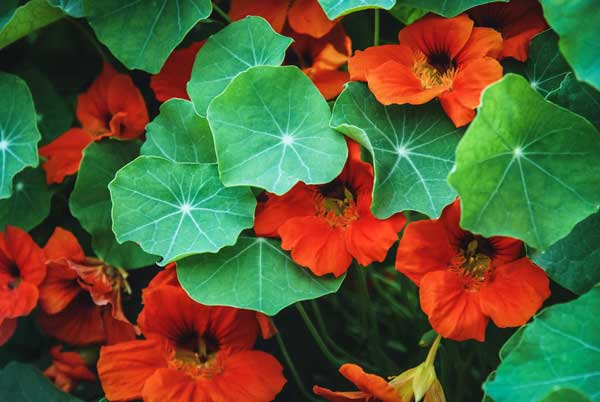
Comfrey
Comfrey, on the other hand, is a fantastic companion for almost any garden plant. It attracts beneficial insects and its deep roots help to bring up nutrients from the subsoil, making those nutrients available to your asparagus and improving overall soil health.

Horseradish
Horseradish is known for its ability to deter pests, thanks to its strong aroma and the compounds it releases into the soil, providing an extra layer of protection for your asparagus.

Alyssum
Planting alyssum alongside asparagus benefits both plants because it attracts beneficial insects that control pests, suppresses weeds as ground cover, improves soil quality, and enhances the garden’s aesthetic appeal.
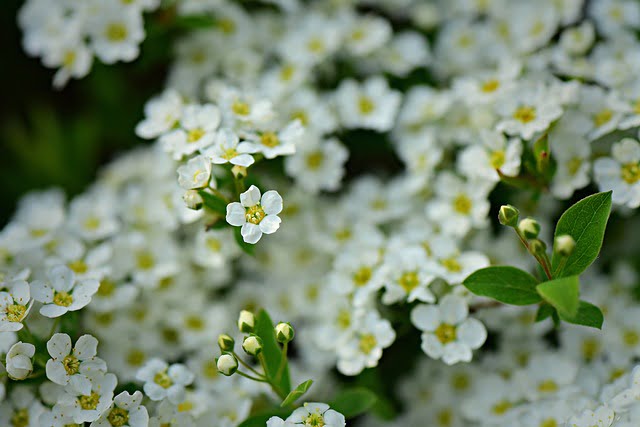
Calendula
Calendula serves as a beneficial companion plant for asparagus by attracting pollinators and beneficial insects, repelling pests, improving soil quality through root action, and enhancing the garden’s biodiversity and aesthetics.

Incorporating these flowers and special mentions into your asparagus companion planting strategy not only enhances the beauty and biodiversity of your garden but also fortifies your asparagus plants against pests and diseases naturally. It’s a holistic approach to gardening that leverages nature’s own mechanisms for a healthier, more productive garden.
What to Avoid: Incompatible Plants for Asparagus
When planning your asparagus garden, it’s just as important to know which plants to avoid as it is to know the best companions. While asparagus enjoys the company of many plants, there are a few that should keep their distance to maintain a happy and healthy garden.
Alliums
First up, alliums, which include onions, garlic, and leeks, might seem like good companions due to their pest-repelling properties. However, they actually aren’t the best neighbors for asparagus. These plants can compete with asparagus for nutrients and might negatively affect its growth. It’s better to give both asparagus and alliums their own space in the garden to thrive.

Potatoes
Potatoes are another crop to keep away from asparagus. Potatoes and asparagus can both be heavy feeders, meaning they might compete for the same nutrients in the soil. Additionally, potatoes can harbor diseases that might affect asparagus plants. It’s wise to plant them in separate areas to avoid any potential issues.

Raspberries
Both raspberries and asparagus are perennial plants that will occupy their space for many years. They can compete for nutrients and water, and raspberries’ sprawling nature and need for support might interfere with the asparagus. It’s generally recommended to keep raspberries in a separate part of the garden.
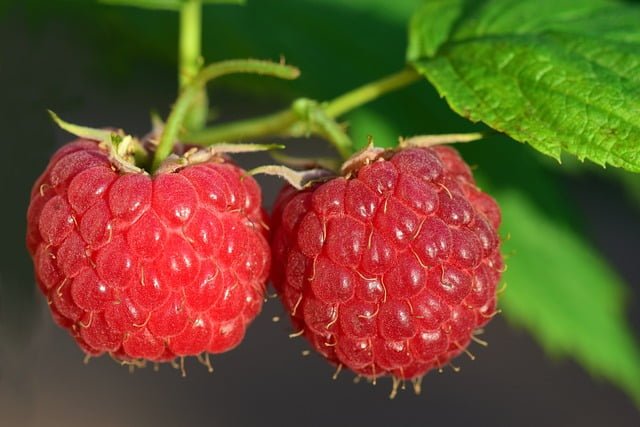
Beans
Intensively planting beans around asparagus can potentially hinder its growth because beans compete with asparagus for space, nutrients, and water if they are planted too closely together. Asparagus, a perennial crop, needs ample space to spread out its roots and grow effectively.

In summary, while companion planting can offer numerous benefits to your asparagus, including improved growth and pest control, it’s crucial to avoid planting asparagus near alliums, potatoes, and beans. Giving these plants their own space allows them to flourish without competing for resources or risking disease transfer, ensuring a bountiful and healthy garden for everyone.
Practical Tips for Implementing Companion Planting
Implementing companion planting in your garden is like setting up a team where every plant has a role that supports the others. Here are some practical tips to make companion planting work for your asparagus and its plant friends:
Start with a Plan: Before planting, sketch out a layout of your garden. Place asparagus where it will get full sunlight and consider the mature sizes of your companion plants to avoid overcrowding. This planning step ensures that every plant has enough space and resources to thrive.
Timing is Key: Plant asparagus in early spring, as soon as the soil can be worked. Companion plants should be timed according to their own needs but in a way that complements the life cycle of asparagus. For example, plant annual companions like lettuce and basil after the asparagus spears have been harvested to use the space efficiently throughout the growing season.
Mind the Spacing: Asparagus plants should be spaced about 12 to 18 inches apart in rows that are 3 to 4 feet apart. Companion plants should be placed so they don’t encroach on this space. For instance, plant low-growing companions like strawberries in between the rows of asparagus, allowing enough room for both to spread.
Consider Height and Shade: Taller companions should be placed on the north side of asparagus to prevent shading. Asparagus enjoys full sun, so it’s important that companion plants don’t block sunlight.
Rotate Companions Annually: If using annual plants as companions, rotate them each year to prevent soil depletion and reduce disease risk. This keeps the soil healthy and benefits all plants in the long run.
Water Wisely: Asparagus and its companions may have different watering needs. Be mindful to water according to each plant’s requirements. Drip irrigation or soaker hoses can provide targeted watering that meets each plant’s needs without overdoing it.
Keep an Eye on Growth: As your plants grow, monitor their health and spacing. Sometimes, plants might grow larger than expected and start to crowd each other. Be prepared to gently relocate some companions if necessary to keep the garden balanced.
By following these practical tips, you can create a harmonious and productive garden where asparagus and its companions support each other. Remember, the key to successful companion planting is observation and adaptation. Watch how your plants interact and be ready to make changes for the best growth. With a little planning and care, your companion-planted garden will be a vibrant, healthy ecosystem.
FAQs on Asparagus Companion Planting
Let’s explore some common questions about companion planting with asparagus, focusing on the choice of male plants for higher yield among other helpful tips:
- Why choose male asparagus plants over female plants?
Male asparagus plants are often recommended because they tend to yield more spears than female plants. Female plants use some of their energy to produce seeds, which can slightly reduce their productivity. Male plants, on the other hand, focus all their energy on growing spears, leading to a larger harvest. - Can I plant flowers with my asparagus?
Yes, flowers like marigolds and nasturtiums are excellent companions for asparagus. Marigolds help deter nematodes in the soil, while nasturtiums can attract pests away from your asparagus, acting as a trap crop. Plus, they add beautiful color to your garden! - What vegetables work well with asparagus?
Vegetables like tomatoes, peas, and lettuce make great companions for asparagus. Tomatoes help repel asparagus beetles, peas enrich the soil with nitrogen, and lettuce can utilize the space efficiently without competing with asparagus for resources. - How should I space my asparagus and its companion plants?
Asparagus should be planted about 12 to 18 inches apart in rows that are 3 to 4 feet apart. Companion plants should be spaced according to their specific needs but placed in a way that they don’t interfere with the asparagus. For example, plant smaller, low-growing companions like strawberries or lettuce between the rows of asparagus. - How does companion planting benefit asparagus?
Companion planting with asparagus can lead to a healthier garden by naturally repelling pests, enriching the soil, and using garden space more efficiently. It also promotes biodiversity by attracting beneficial insects, which can aid in pollination and pest control. - Are there any plants I should avoid planting near asparagus?
Yes, it’s best to avoid planting asparagus near alliums (such as onions and garlic), potatoes, and beans. These plants can compete with asparagus for nutrients or might not be compatible in terms of soil and water needs.
Conclusion
Embarking on asparagus planting offers an adventure into creating a productive and harmonious garden ecosystem. With the right asparagus companion plants, your asparagus crop can thrive, benefiting from mutual support that companion planting offers. Understanding what to plant with asparagus, from beneficial flowers like strawberries to essential herbs, enhances not only the health but also the yield of your asparagus.
However, it’s equally important to be aware of bad companion plants for asparagus. Knowing what not to plant with asparagus helps avoid unnecessary competition and potential pest issues. Ground cover for asparagus and companion plants to asparagus such as peas and lettuce can provide additional benefits, like weed suppression and soil improvement.
As you plan your garden, consider what grows well with asparagus and the variety of asparagus companions available. Whether you’re wondering, “What can I plant with asparagus?” or “What to plant next to asparagus?” the answers include a range of vegetables, herbs, and flowers that not only coexist peacefully but also contribute positively to each other’s well-being.
While asparagus beans companion plants and companion planting asparagus strawberries are popular choices, it’s crucial to tailor your companion planting strategy to your garden’s specific conditions and needs. This approach ensures that each plant, whether it’s asparagus or its companions, has the best possible environment to flourish.
In sum, asparagus planting, with a focus on carefully selected asparagus companion plants, is a strategy that can lead to a healthier, more vibrant garden. By choosing the right companions—knowing both what to plant near asparagus and what to avoid—you set the stage for a successful asparagus crop and a garden ecosystem brimming with life and productivity.
For further exploration of gardening articles, kindly visit our webpage: Home Garden
Lemon Verbena Companion Plants
Companion planting with Asparagus

